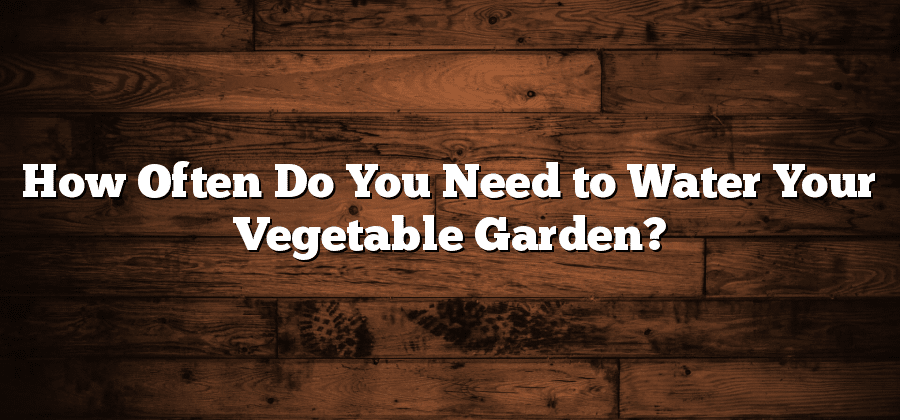Factors Affecting Vegetable Garden Watering
With the right amount of water, your vegetable garden can flourish and yield bountiful harvests throughout the growing season. However, it is essential to understand the factors that affect the watering needs of your plants to ensure optimal growth and avoid potential problems. One crucial factor to consider is the weather conditions. Hot and dry climates will require more frequent watering, while cooler and more humid environments may need less.
Another factor that influences watering is the type of soil in your garden. Different soil types have varying water-holding capacities, which directly affect how often you need to water your vegetables. Sandy soils, for instance, drain water quickly and require more frequent irrigation, whereas clay soils have a greater water-holding capacity and may need less frequent watering. It’s crucial to assess your soil type and make appropriate adjustments to ensure your plants receive the right amount of moisture.
Recognizing Signs of Water Stress in Plants
Plants, just like humans, need water to survive and thrive. However, there are times when they may not receive adequate amounts of water, resulting in water stress. The ability to recognize the signs of water stress in plants is crucial for gardeners as it allows them to take appropriate action and prevent any potential damage to their vegetable crops.
One of the most visible signs of water stress in plants is wilting. When plants lack sufficient water, their leaves may become droopy, limp, and noticeably less turgid. Another indicator is the change in leaf color. Leaves of water-stressed plants may turn yellow or brown, reflecting their struggle to perform vital metabolic processes. Additionally, the edges of the leaves may appear scorched or curled, further indicating a lack of water. By observing and understanding these signs, gardeners can quickly identify water-stressed plants and intervene with timely watering to ensure their health and vitality.
Understanding the Water Needs of Different Vegetable Types
Vegetable gardening is a delicate art that requires a deep understanding of the unique water needs of different vegetable types. When it comes to watering your vegetables, a one-size-fits-all approach simply won’t do. Each vegetable has its own specific requirements, dictated by factors such as its size, root depth, and growth stage.
For example, leafy greens such as lettuce and spinach require a consistent supply of water to thrive. These vegetables have shallow roots, so they rely on frequent watering to keep their soil consistently moist. On the other hand, root vegetables like carrots and radishes need less frequent watering, as their roots can reach deeper into the soil to find moisture. Overwatering root vegetables can lead to rot or poor quality produce. Understanding these variations in water needs is crucial to ensuring optimal growth and yield in your vegetable garden.
Moreover, it’s important to take into account the life cycle of each vegetable when determining its water requirements. Young seedlings, for instance, need more frequent watering to establish their roots and support rapid growth. As they mature, some vegetables become more drought-tolerant and require less water. Tomatoes, for instance, require more water during the initial stages of fruit development, but once the fruits start ripening, they can handle drier conditions. Adjusting your watering schedule accordingly will help you provide the right amount of moisture at the right time for each vegetable type.
By understanding the specific water needs of different vegetable types, you can tailor your watering practices to maximize their growth and health, all while conserving water. Monitoring the soil moisture, observing plant behavior, and learning from experience will enable you to become a master of providing the perfect hydration for your vegetable garden. With these insights, your garden will flourish, resulting in a bountiful harvest of vibrant and tasty vegetables.
Determining the Ideal Soil Moisture Level
Soil moisture plays a crucial role in the overall health and productivity of vegetable gardens. Determining the ideal soil moisture level is essential for providing plants with the right amount of water they need to thrive. Overwatering or underwatering can have detrimental effects on the growth and development of vegetables.
To determine the ideal soil moisture level, gardeners can use a simple and effective method: the finger test. Insert your index finger about an inch deep into the soil near the plants. If the soil feels dry at this depth, it indicates that watering is required. On the other hand, if the soil feels excessively wet or soggy, it suggests that watering should be reduced or withheld until the soil dries out slightly. Repeat the finger test in several areas of the garden to get a comprehensive understanding of the moisture levels throughout the soil.
Achieving the ideal soil moisture level is an ongoing process that requires regular monitoring and adjustments. It is important to remember that different vegetable types have varying water needs. Factors such as the climate, humidity, and type of soil also influence water retention. By paying attention to these factors and using methods like the finger test, gardeners can ensure that their vegetable plants receive the right amount of water, leading to optimal growth and harvest.
The Importance of Proper Drainage in Vegetable Gardens
Proper drainage is a crucial component for the success of vegetable gardens. When it comes to growing vegetables, water management is essential to ensure healthy plant growth and abundant yields. Without adequate drainage, excess water can accumulate in the soil, leading to several problems.
One of the risks associated with poor drainage is root rot. When the soil becomes waterlogged, the roots are deprived of oxygen, leading to their decay. This can severely weaken the plants and even cause their death. Additionally, excessive moisture can promote the growth of harmful fungi and bacteria, which can further damage the roots and spread diseases to the entire garden. Therefore, ensuring proper drainage is essential to create an optimal growing environment for your vegetables.






